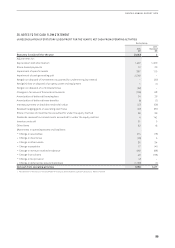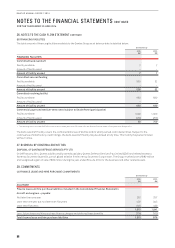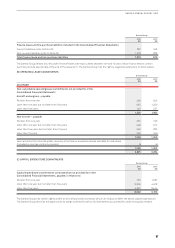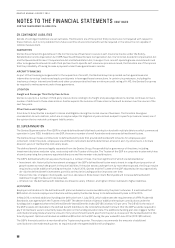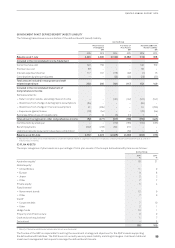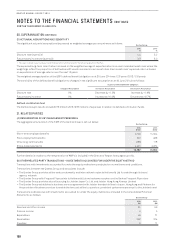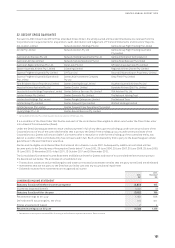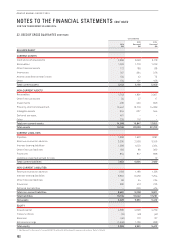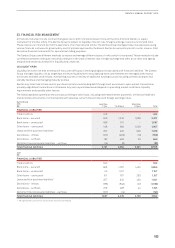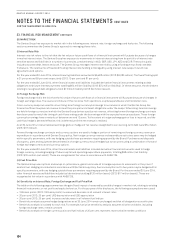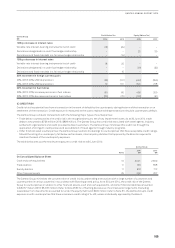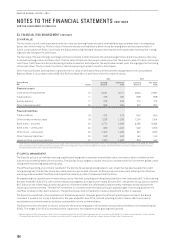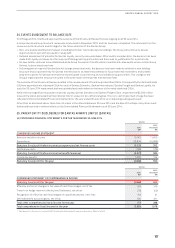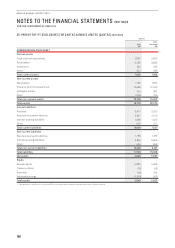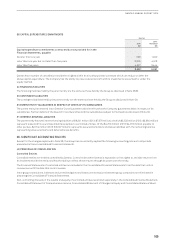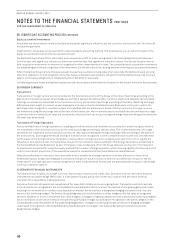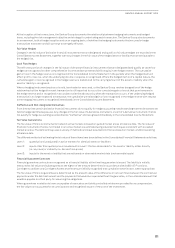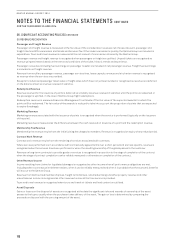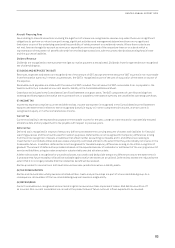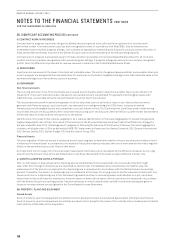Qantas 2014 Annual Report Download - page 106
Download and view the complete annual report
Please find page 106 of the 2014 Qantas annual report below. You can navigate through the pages in the report by either clicking on the pages listed below, or by using the keyword search tool below to find specific information within the annual report.
104
QANTAS ANNUAL REPORT 2014
NOTES TO THE FINANCIAL STATEMENTS CONTINUED
FOR THE YEAR ENDED 30 JUNE 2014
33. FINANCIAL RISK MANAGEMENT CONTINUED
(B) MARKET RISK
The Qantas Group has exposure to market risk in the following areas: interest rate, foreign exchange and fuel price. The following
section summarises the Qantas Group’s approach to managing these risks.
(i) Interest Rate Risk
Interest rate risk refers to the risk that the fair value or future cash flows of a financial instrument will fluctuate because of changes
in market interest rates. The Qantas Group has exposure to movements in interest rates arising from its portfolio of interest rate
sensitive assets and liabilities in a number of currencies, predominantly in AUD, GBP, USD, JPY, NZD and EUR. These principally
include corporate debt, leases and cash. The Qantas Group manages interest rate risk by using a floating versus fixed rate debt
framework. The relative mix of fixed and floating interest rate funding is managed by using interest rate swaps, forward rate
agreements and options.
For the year ended 30 June 2014, interest-bearing liabilities amounted to $6,483million (2013: $6,080million). The fixed/floating split
is 31 per cent and 69 per cent respectively (2013: 19 per cent and 81 per cent).
For the year ended 30 June 2014, other financial assets and liabilities included derivative financial instruments relating to debt
obligations and future interest payments totalling $64million (liability) (2013: $74million (liability)). Of these amounts, the derivatives
relating to recognised debt obligations total $7million (liability) (2013: $4million (asset)).
(ii) Foreign Exchange Risk
Foreign exchange risk is the risk that the fair value of future cash flows of a financial instrument will fluctuate because of changes in
foreign exchange rates. The source and nature of this risk arise from operations, capital expenditures and translation risks.
Cross-currency swaps are used to convert long-term foreign currency borrowings to currencies in which the Qantas Group has
forecast sufficient surplus net revenue to meet the principal and interest obligations under the swaps. Where long-term borrowings
are held in foreign currencies in which the Qantas Group derives surplus net revenue, offsetting forward foreign exchange contracts
have been used to match the timing of cash flows arising under the borrowings with the expected revenue surpluses. These foreign
currency borrowings have a maturity of between one and 12 years. To the extent a foreign exchange gain or loss is incurred, and the
cash flow hedge is deemed effective, this is deferred until the net revenue is realised.
As at 30 June 2014, total unrealised exchange gains on hedges of net revenue designated to service long-term debt were $54million
(2013: $115million).
Forward foreign exchange contracts and currency options are used to hedge a portion of remaining net foreign currency revenue or
expenditure in accordance with Qantas Group policy. Net foreign currency revenue and expenditure out to two years may be hedged
within specific parameters, with any hedging outside these parameters requiring approval by the Board. Purchases and disposals
of property, plant and equipment denominated in a foreign currency may be hedged out to two years using a combination of forward
foreign exchange contracts and currency options.
For the year ended 30 June 2014, other financial assets and liabilities included derivative financial instruments used to hedge
foreign currency, including hedging of future capital and operating expenditure payments, totalling $98million (net liability)
(2013:$124million (net asset)). These are recognised at fair value in accordance with AASB 139.
(iii) Fuel Price Risk
The Qantas Group uses options and swaps on jet kerosene, gasoil and crude oil to hedge exposure to movements in the price of
aviation fuel. Hedging is conducted in accordance with Qantas Group policy. Fuel consumption out to two years may be hedged within
specific parameters, with any hedging outside these parameters requiring approval by the Board. For the year ended 30June2014,
other financial assets and liabilities include fuel derivatives totalling $120million (asset) (2013: $17million (asset)). These are
recognised at fair value in accordance with AASB 139.
(iv) Sensitivity on Interest Rate, Foreign Exchange and Fuel Price Risk
The table on the following page summarises the gain/(loss) impact of reasonably possible changes in market risk, relating to existing
financial instruments, on net profit and equity before tax. For the purpose of this disclosure, the following assumptions were used:
–100 basis points (2013: 100 basis points) increase and decrease in all relevant interest rates
–20 per cent (2013: 20 per cent) USD depreciation and USD appreciation
–20 per cent (2013: 20 per cent) increase and decrease in all relevant fuel indices
–Sensitivity analysis assumes hedge designations as at 30 June 2014 remain unchanged and that all designations are effective
–Sensitivity analysis is isolated for each risk. For example, fuel price sensitivity analysis assumes all other variables, including
foreign exchange rates, remain constant
–Sensitivity analysis on foreign currency pairs and fuel indices of 20 per cent represent recent volatile market conditions



